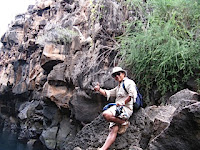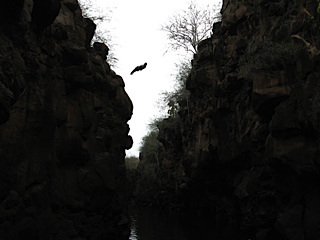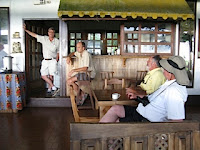Just when we thought it couldn’t get any better, little did we know that the best-of-the best was still awaiting us. We’d had some easy going read-your-book and kayak around-the-bay days in between, but the true highlights of the trip were yet to come.
The first took place at “Playa La Fe” (Faith Beach), a hidden paradise not normally featured in the local tour shops. We were offered the unique chance to be taken there by a boat captain and island guide Luis, and boy, did he ever treat us
to a very special paradise.
to a very special paradise.
 We cruised along, enjoying the coastal view for about a half hour. When he slowed down, strangely, all we could see was a thin, black, getty-like line of rocks. Luis took his time, carefully riding in on the low tide waves and into a cove. Pristine emerald water beneath us, we’d just entered into the most magical estuary we’d ever seen. Sea lions, marine iguanas, pelicans and frigates lazed contentedly on the rocks on the sides of this narrow canal. Still, we couldn’t see a beach and I started to wonder if it even existed. Then we turned left, and tucked into themangrove was a tiny little “beach” area ~ larger now because it was low tide, but you could see clearly how most of it would fill in later to the tide line.
We cruised along, enjoying the coastal view for about a half hour. When he slowed down, strangely, all we could see was a thin, black, getty-like line of rocks. Luis took his time, carefully riding in on the low tide waves and into a cove. Pristine emerald water beneath us, we’d just entered into the most magical estuary we’d ever seen. Sea lions, marine iguanas, pelicans and frigates lazed contentedly on the rocks on the sides of this narrow canal. Still, we couldn’t see a beach and I started to wonder if it even existed. Then we turned left, and tucked into themangrove was a tiny little “beach” area ~ larger now because it was low tide, but you could see clearly how most of it would fill in later to the tide line.We settled in, and Luis took us for an even greater surprise through a

 tough-going rocky path of black volcanic rocks behind the site. Incredible in itself, I could imagine the original red-hot lava flowing to the sea at the island’s birth. Making it through to the other side, it opened up to the open sea. We were stunned. Marine iguanas were everywhere - large and small; out in the open, and tucked under the rocks beneath our feet. It was wild. Luis recommended we come back later at higher tide, because he said right now most were out feeding in the water. We did, and again, it was just pure fascination.
tough-going rocky path of black volcanic rocks behind the site. Incredible in itself, I could imagine the original red-hot lava flowing to the sea at the island’s birth. Making it through to the other side, it opened up to the open sea. We were stunned. Marine iguanas were everywhere - large and small; out in the open, and tucked under the rocks beneath our feet. It was wild. Luis recommended we come back later at higher tide, because he said right now most were out feeding in the water. We did, and again, it was just pure fascination.
Luis took us snorkeling in the canal, and we traveled along, enjoying the
myriad of lovely fish living in the volcanic rocks on the sides. Luis brought us a sea urchin, and placed it in my hand. Tan and brown with a touch of white, it felt slightly prickly. He motioned underwater to flip my palm over. It stuck! We all took turns, and Luis made sure we didn’t take it out of the water in order to protect it. We then continued on, seeing a sleeping manta ray, more gorgeous and curious fish, and a sea turtle flying gently by.
myriad of lovely fish living in the volcanic rocks on the sides. Luis brought us a sea urchin, and placed it in my hand. Tan and brown with a touch of white, it felt slightly prickly. He motioned underwater to flip my palm over. It stuck! We all took turns, and Luis made sure we didn’t take it out of the water in order to protect it. We then continued on, seeing a sleeping manta ray, more gorgeous and curious fish, and a sea turtle flying gently by.
We alternated between the beach and snorkeling, but were more often in than out. The iguanas stayed just feet away. Most beautiful was a mother sea lion and her pup, nursing in the mangroves. We could hear their hoarse, excited barks - especially when the baby must have bit mom’s nipple. So, so fascinating. What a treat.
 The best, though, was when a playful sea lion pup came over to us and started playing, weaving through us all as we stood in the water. Oh, my gosh, it was the BEST! I moved away to snorkel on my own, and she came up and swam with me. She darted this way and that, dashing sleekly around and under me. I played with her, and mimicked her, stretching my arms out over my head. She teased me so, and I wanted to run my hand down that long, beautiful belly (button and all!) but I wouldn’t out of respect. Just as curious, I swear she wanted to touch me, too. And that face with her little ear flaps - so adorable. But then she shot away. Minutes later she was back, teasing as if to say, “Come on, let’s play again!” Truly magical.
The best, though, was when a playful sea lion pup came over to us and started playing, weaving through us all as we stood in the water. Oh, my gosh, it was the BEST! I moved away to snorkel on my own, and she came up and swam with me. She darted this way and that, dashing sleekly around and under me. I played with her, and mimicked her, stretching my arms out over my head. She teased me so, and I wanted to run my hand down that long, beautiful belly (button and all!) but I wouldn’t out of respect. Just as curious, I swear she wanted to touch me, too. And that face with her little ear flaps - so adorable. But then she shot away. Minutes later she was back, teasing as if to say, “Come on, let’s play again!” Truly magical. We took Luis’s advice and went back over to the other side. He was right. Iguanas were everywhere! It was hard to avoid them, and sometimes if you got too close they’d spit out their nose or tick their heads back and forth in warning. The larger ones did that to the smaller ones in domination, too. Some were darker, and others were orange and rainbow-colored with cool spiky crests. When they swam, they tucked their clawed arms sleekly by their sides and navigate with their tails. Fascinating.
We took Luis’s advice and went back over to the other side. He was right. Iguanas were everywhere! It was hard to avoid them, and sometimes if you got too close they’d spit out their nose or tick their heads back and forth in warning. The larger ones did that to the smaller ones in domination, too. Some were darker, and others were orange and rainbow-colored with cool spiky crests. When they swam, they tucked their clawed arms sleekly by their sides and navigate with their tails. Fascinating. 


























